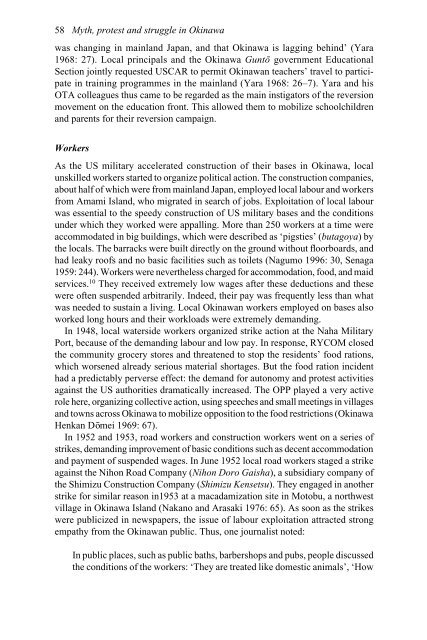Myth, Protest and Struggle in Okinawa
Myth, Protest and Struggle in Okinawa
Myth, Protest and Struggle in Okinawa
You also want an ePaper? Increase the reach of your titles
YUMPU automatically turns print PDFs into web optimized ePapers that Google loves.
58 <strong>Myth</strong>, protest <strong>and</strong> struggle <strong>in</strong> Ok<strong>in</strong>awa<br />
was chang<strong>in</strong>g <strong>in</strong> ma<strong>in</strong>l<strong>and</strong> Japan, <strong>and</strong> that Ok<strong>in</strong>awa is lagg<strong>in</strong>g beh<strong>in</strong>d’ (Yara<br />
1968: 27). Local pr<strong>in</strong>cipals <strong>and</strong> the Ok<strong>in</strong>awa Guntō government Educational<br />
Section jo<strong>in</strong>tly requested USCAR to permit Ok<strong>in</strong>awan teachers’ travel to participate<br />
<strong>in</strong> tra<strong>in</strong><strong>in</strong>g programmes <strong>in</strong> the ma<strong>in</strong>l<strong>and</strong> (Yara 1968: 26–7). Yara <strong>and</strong> his<br />
OTA colleagues thus came to be regarded as the ma<strong>in</strong> <strong>in</strong>stigators of the reversion<br />
movement on the education front. This allowed them to mobilize schoolchildren<br />
<strong>and</strong> parents for their reversion campaign.<br />
Workers<br />
As the US military accelerated construction of their bases <strong>in</strong> Ok<strong>in</strong>awa, local<br />
unskilled workers started to organize political action. The construction companies,<br />
about half of which were from ma<strong>in</strong>l<strong>and</strong> Japan, employed local labour <strong>and</strong> workers<br />
from Amami Isl<strong>and</strong>, who migrated <strong>in</strong> search of jobs. Exploitation of local labour<br />
was essential to the speedy construction of US military bases <strong>and</strong> the conditions<br />
under which they worked were appall<strong>in</strong>g. More than 250 workers at a time were<br />
accommodated <strong>in</strong> big build<strong>in</strong>gs, which were described as ‘pigsties’ (butagoya)by<br />
the locals. The barracks were built directly on the ground without floorboards, <strong>and</strong><br />
had leaky roofs <strong>and</strong> no basic facilities such as toilets (Nagumo 1996: 30, Senaga<br />
1959: 244). Workers were nevertheless charged for accommodation, food, <strong>and</strong> maid<br />
services. 10 They received extremely low wages after these deductions <strong>and</strong> these<br />
were often suspended arbitrarily. Indeed, their pay was frequently less than what<br />
was needed to susta<strong>in</strong> a liv<strong>in</strong>g. Local Ok<strong>in</strong>awan workers employed on bases also<br />
worked long hours <strong>and</strong> their workloads were extremely dem<strong>and</strong><strong>in</strong>g.<br />
In 1948, local waterside workers organized strike action at the Naha Military<br />
Port, because of the dem<strong>and</strong><strong>in</strong>g labour <strong>and</strong> low pay. In response, RYCOM closed<br />
the community grocery stores <strong>and</strong> threatened to stop the residents’ food rations,<br />
which worsened already serious material shortages. But the food ration <strong>in</strong>cident<br />
had a predictably perverse effect: the dem<strong>and</strong> for autonomy <strong>and</strong> protest activities<br />
aga<strong>in</strong>st the US authorities dramatically <strong>in</strong>creased. The OPP played a very active<br />
role here, organiz<strong>in</strong>g collective action, us<strong>in</strong>g speeches <strong>and</strong> small meet<strong>in</strong>gs <strong>in</strong> villages<br />
<strong>and</strong> towns across Ok<strong>in</strong>awa to mobilize opposition to the food restrictions (Ok<strong>in</strong>awa<br />
Henkan Dōmei 1969: 67).<br />
In 1952 <strong>and</strong> 1953, road workers <strong>and</strong> construction workers went on a series of<br />
strikes, dem<strong>and</strong><strong>in</strong>g improvement of basic conditions such as decent accommodation<br />
<strong>and</strong> payment of suspended wages. In June 1952 local road workers staged a strike<br />
aga<strong>in</strong>st the Nihon Road Company (Nihon Doro Gaisha), a subsidiary company of<br />
the Shimizu Construction Company (Shimizu Kensetsu). They engaged <strong>in</strong> another<br />
strike for similar reason <strong>in</strong>1953 at a macadamization site <strong>in</strong> Motobu, a northwest<br />
village <strong>in</strong> Ok<strong>in</strong>awa Isl<strong>and</strong> (Nakano <strong>and</strong> Arasaki 1976: 65). As soon as the strikes<br />
were publicized <strong>in</strong> newspapers, the issue of labour exploitation attracted strong<br />
empathy from the Ok<strong>in</strong>awan public. Thus, one journalist noted:<br />
In public places, such as public baths, barbershops <strong>and</strong> pubs, people discussed<br />
the conditions of the workers: ‘They are treated like domestic animals’, ‘How
















